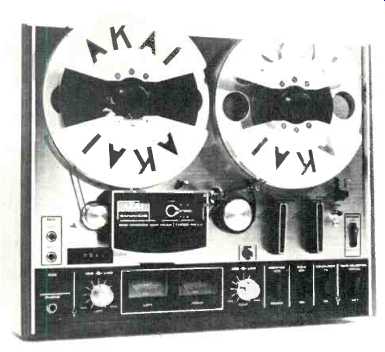
MANUFACTURER'S SPECIFICATIONS:
Speeds: 3 3/4 and 7 1/2 ips.
Frequency Response: 30 to 23,000 Hz ± 3 dB at 7 1/2 ips; 30 to 16,000 Hz ± 3 dB at 3 3/4 ips.
Signal-to-Noise: Better than 50 dB.
Erase Ratio: Better than 70 dB.
Wow and Flutter: Less than 0.15% rms at 7 1/2 ips; less than 0.2% at 3 3/4 ips.
Distortion: Less than 1.5% (1000 Hz, 0 VU).
Heads: Three, record, playback, and erase.
Reel Size: 7-inch maximum.
Dimensions: 16 in. W x 12 1/2 in. H x 7 1/2 in. D.
Weight: 25 lbs.
Price: $269.95.
The name AKAI is a well-respected one in the tape recorder world, and they are especially remembered for their pioneering work with the cross-field head technique--a remarkable innovation in the days before low-noise tapes. They now have a wide range of high-fidelity products including receivers, amplifiers and preamplifiers, loudspeakers, open-reel recorders and cassette machines. One of these cassette recorders, the GXC-46D with Dolby system, was in fact reviewed in the November, 1973 issue.
The Model 4000DS reviewed here is a relatively inexpensive 4-track machine with a good all-round performance and having some interesting features like provision for sound-on sound, automatic shut-off, a track selector switch and a monitor head. It is somewhat smaller than most open-reel machines, measuring 16 by 12 inches high and about 7 inches deep. On the extreme left hand side are the microphone input sockets and one for headphones. To the right of these is a dual-concentric control for line and microphone inputs to the left channel. On the other side of the two illuminated VU meters is a similar dual control for the right channel and then come four rocker switches for tape monitor, sound-on-sound, tape equalizer for 3 3/4 and 7 1/2 ips, and tape selector for normal and S.R.T. Above this one is another rocker switch for on-off. The front panel, on which are situated the VU meters and most of the controls, is finished in a charcoal black giving a pleasing contrast to the brushed silver top plate.
Tape control functions are shared by two large rotary lever switches, one for stop, forward, and record and the other for fast forward and rewind. The record push button is located below the capstan, and a digital counter is situated just to the left of the head cover. This cover is a handsome piece of die-casting on which is mounted a channel selector switch inscribed 3-2, stereo and 1-4. A pause control in the form of a lever is located above the on-off switch, and there is also a push button for a quick start. Input and output sockets (including a DIN type) are all located in a recess at the rear.
The equalizer switch does just that-there is no speed-change control as such and the user has to remove a sleeve from the capstan to change speeds from 7 1/2 down to 3 3/4 ips. This sleeve is then placed (or should be placed) on a storage post which is mounted near the aforesaid capstan.
Although there are separate recording and playback heads, I was interested to see that both had one-micron gaps-most unusual (see Fig. 1). The motor is a 4-pole induction type turning at 1800 rpm (on 60 Hz, that is)--see Fig. 2. Eleven transistors are used, together with four ICs, and headphone output is taken through a step-down transformer. The bias oscillator is a normal push-pull arrangement with a frequency of 105 kHz.
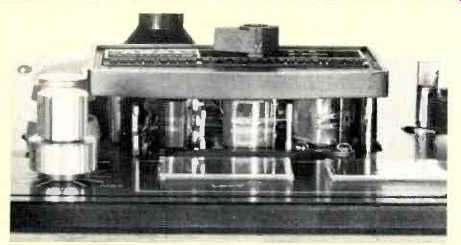
Fig. 1--Head assembly.
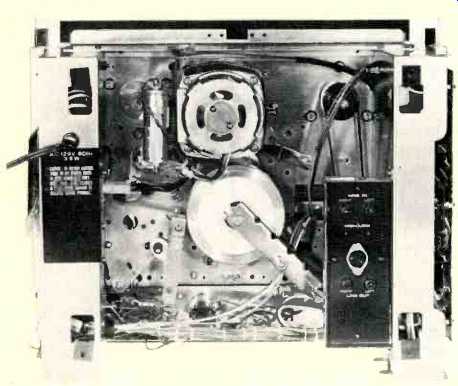
Fig. 2--View of the chassis.
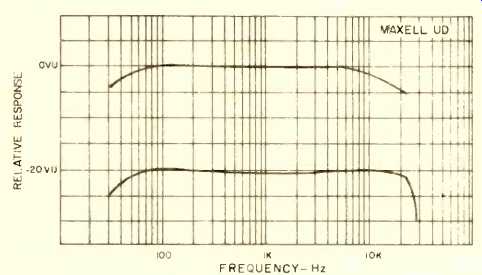
Fig. 3--Record-replay response at 7 1/2ips.
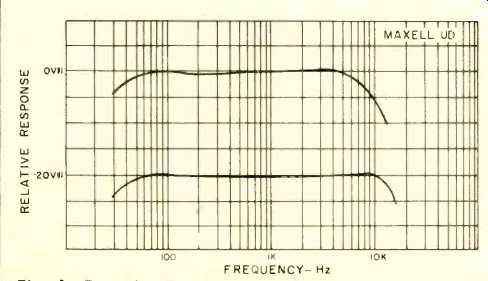
Fig. 4--Record-replay response at 3 3/4 ips.
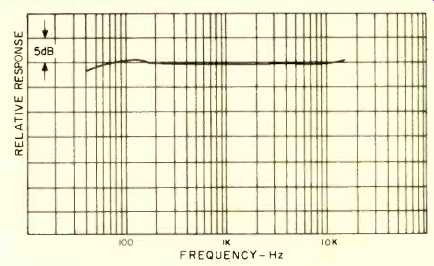
Fig. 5--Playback response with standard tape.
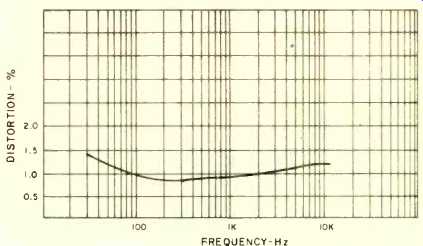
Fig. 6--Distortion vs. frequency (0 VU).
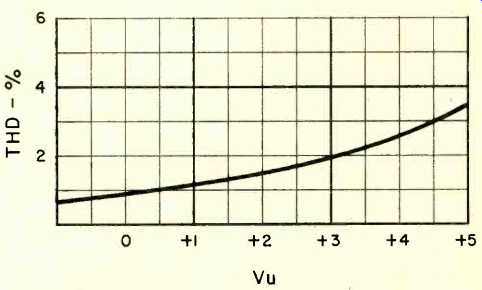
Fig. 7--Total harmonic distortion at 1 kHz.
Measurements
Figure 3 shows the frequency response at 7 1/2 ips with Maxell UD tape. The 3 dB point is 24 kHz-slightly better than the specifications. Response at 3 3/4 ips is seen in the next graph (Fig. 4), and here the 3 dB point is nearly 17 kHz, which would be considered excellent for 7 1/2 ips not so long ago! Figure 5 shows the playback response with a standard test tape, and the distortion characteristics are shown in Figs. 6 and 7. The THD at 0 VU is generally less than one percent, increasing to 3.8 percent at +5 VU. Signal to noise was 53 dB referred to 0 VU or 56 dB referred to +3 VU. You can put it another way and say it was 57 dB at 3 percent distortion. Figures for 3 3/4 ips were just over 2 dB less in each case. Sensitivity for 0 VU was 44 millivolts line and 0.6 millivolts at the microphone input. Output was 1.2 volts. Wow and flutter was excellent for a machine in this price range being 0.12 percent at 7 1/2 ips and 0.15 percent at 3 3/4 using the DIN record-replay standard. Finally, the tape rewind time was 210 seconds for 1800 feet. If these figures are compared with the specifications, it will be seen that the maker's ratings are quite conservative.
In-Use Test
The 4000DS was used with a Sansui 9500 integrated amplifier and a Thorens 125 turntable fitted with a Shure Mk. III cartridge. Several tapes were made from records including some CBS SQ discs. Two sound-on-sound recordings were also made. To do this, a recording is made on one track in the normal manner. The tape is then rewound to the starting point using the counter and another track recorded while monitoring the first track. The tape is rewound again and the process is repeated again for tracks three and four.
For playback, the track selector switch is set to the track on which the last recording is made and the mono mode selected by pulling the right level control knob outwards.
This kind of thing is very useful for the amateur composer or possibly for language training. Full instructions are given in the owner's manual, which points out that as many individual recordings as desired can be transferred to a single track.
The manual also describes the procedure for sound-with-sound, sound mixing, head cleaning, and tape splicing.
The two tape function knobs worked quite smoothly although it took some time before I got completely used to them. For instance, the stop position is not marked so I had to hesitate a split second before I turned the right knob the right way. I had no difficulty with the speed change modus operandi-mainly because I rarely use 3 3/4 ips. However, I can imagine that some people would feel a little frustrated at the lack of a speed-change switch. But again, this is an inexpensive machine, in fact, a remarkably inexpensive machine. In terms of basic performance, especially frequency response, distortion and wow and flutter, it compares very favorably with recorders costing much more. Certainly, it has more to offer than cassette units in the same price range.
-George W. Tillett
(Audio magazine, May 1974)
Also see:
Akai Model GX 267D Open-Reel Tape Deck (Jun. 1979)
Akai's 4-Channel Challenge (Dec. 1973)
= = = =